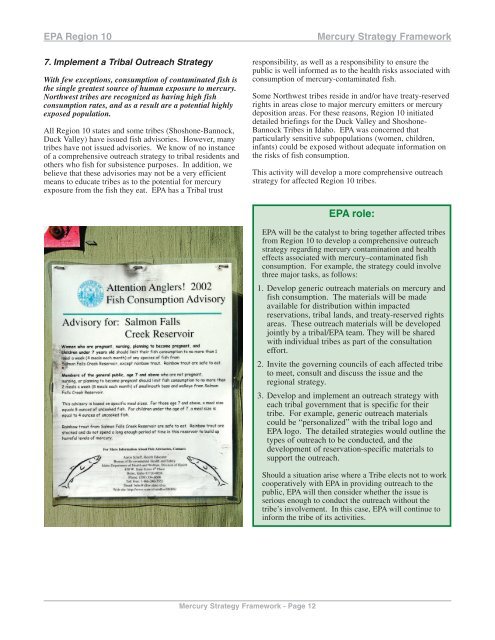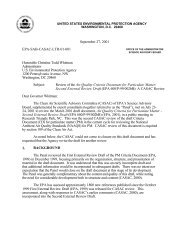EPA Region 10 Mercury Strategy Framework - Environmental ...
EPA Region 10 Mercury Strategy Framework - Environmental ...
EPA Region 10 Mercury Strategy Framework - Environmental ...
- No tags were found...
You also want an ePaper? Increase the reach of your titles
YUMPU automatically turns print PDFs into web optimized ePapers that Google loves.
<strong>EPA</strong> <strong>Region</strong> <strong>10</strong>7. Implement a Tribal Outreach <strong>Strategy</strong>With few exceptions, consumption of contaminated fish isthe single greatest source of human exposure to mercury.Northwest tribes are recognized as having high fishconsumption rates, and as a result are a potential highlyexposed population.All <strong>Region</strong> <strong>10</strong> states and some tribes (Shoshone-Bannock,Duck Valley) have issued fish advisories. However, manytribes have not issued advisories. We know of no instanceof a comprehensive outreach strategy to tribal residents andothers who fish for subsistence purposes. In addition, webelieve that these advisories may not be a very efficientmeans to educate tribes as to the potential for mercuryexposure from the fish they eat. <strong>EPA</strong> has a Tribal trust<strong>Mercury</strong> <strong>Strategy</strong> <strong>Framework</strong>responsibility, as well as a responsibility to ensure thepublic is well informed as to the health risks associated withconsumption of mercury-contaminated fish.Some Northwest tribes reside in and/or have treaty-reservedrights in areas close to major mercury emitters or mercurydeposition areas. For these reasons, <strong>Region</strong> <strong>10</strong> initiateddetailed briefings for the Duck Valley and Shoshone-Bannock Tribes in Idaho. <strong>EPA</strong> was concerned thatparticularly sensitive subpopulations (women, children,infants) could be exposed without adequate information onthe risks of fish consumption.This activity will develop a more comprehensive outreachstrategy for affected <strong>Region</strong> <strong>10</strong> tribes.<strong>EPA</strong> role:<strong>EPA</strong> will be the catalyst to bring together affected tribesfrom <strong>Region</strong> <strong>10</strong> to develop a comprehensive outreachstrategy regarding mercury contamination and healtheffects associated with mercury–contaminated fishconsumption. For example, the strategy could involvethree major tasks, as follows:1. Develop generic outreach materials on mercury andfish consumption. The materials will be madeavailable for distribution within impactedreservations, tribal lands, and treaty-reserved rightsareas. These outreach materials will be developedjointly by a tribal/<strong>EPA</strong> team. They will be sharedwith individual tribes as part of the consultationeffort.2. Invite the governing councils of each affected tribeto meet, consult and discuss the issue and theregional strategy.3. Develop and implement an outreach strategy witheach tribal government that is specific for theirtribe. For example, generic outreach materialscould be “personalized” with the tribal logo and<strong>EPA</strong> logo. The detailed strategies would outline thetypes of outreach to be conducted, and thedevelopment of reservation-specific materials tosupport the outreach.Should a situation arise where a Tribe elects not to workcooperatively with <strong>EPA</strong> in providing outreach to thepublic, <strong>EPA</strong> will then consider whether the issue isserious enough to conduct the outreach without thetribe’s involvement. In this case, <strong>EPA</strong> will continue toinform the tribe of its activities.<strong>Mercury</strong> <strong>Strategy</strong> <strong>Framework</strong> - Page 12
















